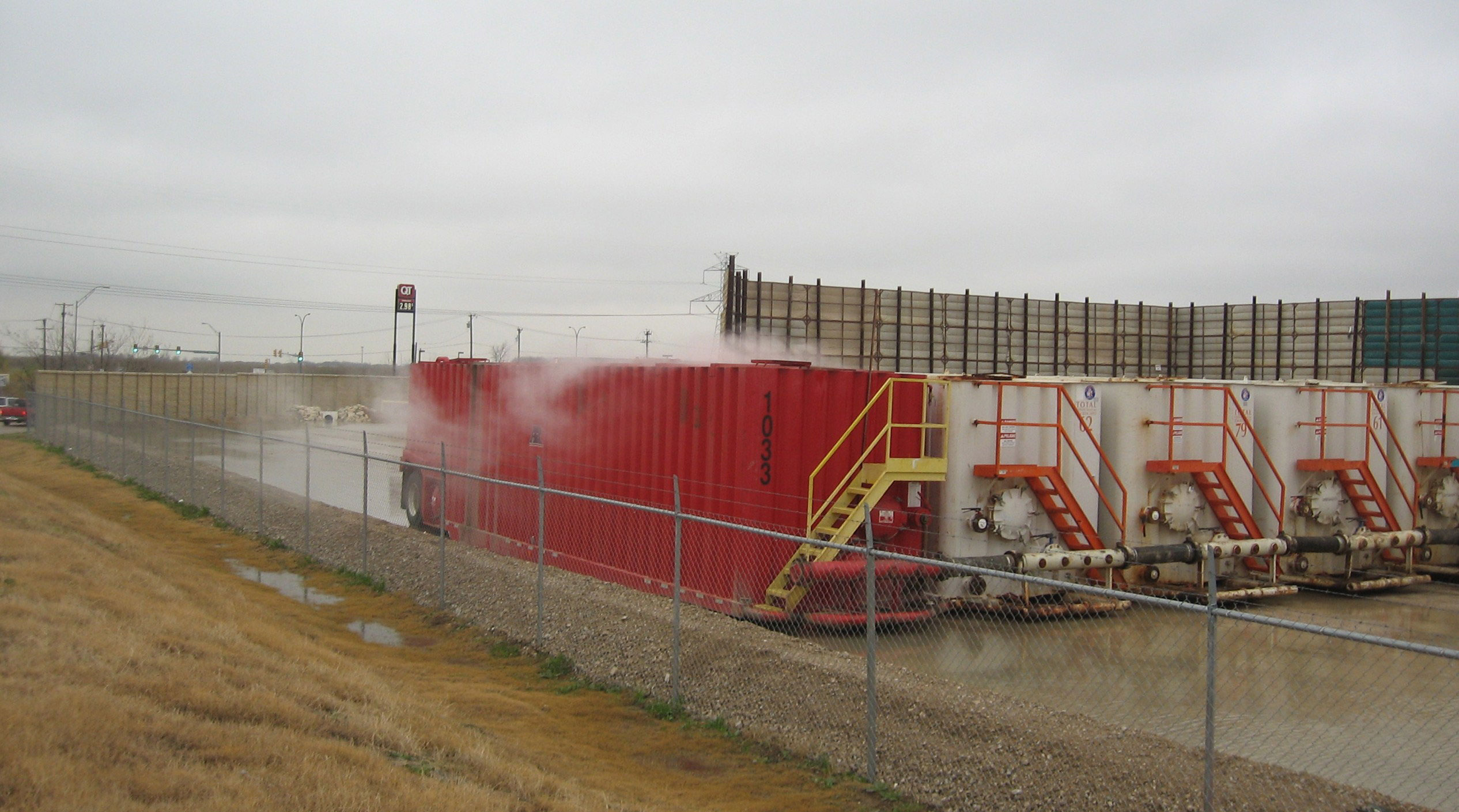Residents of several Arlington neighborhoods where Chesapeake Energy is drilling for natural gas claim the vapor clouds released by certain stages of the operations are making them sick — and they’re challenging the company to allow outside monitoring of the emissions.
Numerous people living in the Fish Creek, Norwood, Oaks, and Interlochen neighborhoods say they are getting nosebleeds, headaches, and other ailments when Chesapeake conducts fracking: shooting millions of gallons of chemical-laced water deep into underground shale formations to release trapped natural gas.
Residents’ problems, they say, occur during the flowback stage of fracking, a several-days-long process when the extremely salty and toxic liquid returns to the surface. Some residents have teamed up with the Texas Oil and Gas Accountability Project, which is part of the Earthworks environmental group, an organization dedicated to protecting communities from the effects of irresponsible mineral and energy development. The residents said Chesapeake has long ignored their good-faith pleas to control the emissions.
Chesapeake spokespersons say the vapor clouds are clean steam from hot water.
The neighbors, according to a press release, are specifically asking Chesapeake to “provide independent verification of the company’s claim that fumes released from Chesapeake facilities … were simply steam — and therefore could not have caused harm to area residents.”
Jane Lynn reported suffering heart palpitations a few minutes after a vapor cloud enveloped her in her Fish Creek neighborhood. “Last December they were flowing back a well in my neighborhood, so I decided to take pictures of the escaping vapor,” Lynn said. “I was literally in the vapor cloud, and the odor was overwhelmingly strong. Within minutes there was tightness in my chest. Later that day I began getting heart palpitations — which I’ve only gotten previously when exposed to gas escaping from a well site.”
The previous December, while Chesapeake was flowing back another nearby well, both Lynn’s husband and a neighbor’s son got nosebleeds, she said, “and in the 25 years I’ve known my husband, he’d never had a nosebleed before.”
Nosebleeds and heart palpitations, as well as nausea and headaches, are common around gas drilling operations (“Sacrificed to Shale,” Fort Worth Weekly, Oct. 14, 2009).
Arlington resident Ranjana Bhandari said she was stuck at a traffic light when fumes from a nearby well caused her face and sinuses to begin hurting and gave her son a headache. “The symptoms lasted for hours and then returned when I was stuck at a railway crossing in the vicinity a few days later,” she said.
Jean Stephens had walked out of her Design Center store on South Bowen Road in Arlington and was overcome with nausea and an inability to breathe when a vapor cloud blew through her parking lot. “It was just a severely nauseating foul odor,” she said. “I’d never smelled it before. I was so sick that I didn’t even think to call the fire department for about 20 minutes. And by the time they came a few minutes later, it was largely dissipated. It just came and went.”
Chesapeake did not respond to requests for comment from Fort Worth Weekly. However, according to the press release, Julie Wilson, Chesapeake’s vice-president for urban development, did respond to public inquiries about the fumes.
In an e-mail to one Arlington resident posted on anti-drilling activist Kim Feil’s website (Barnettshalehell.wordpress.com), Wilson noted, “Our staff has investigated your concern and is happy to report there are no issues. The ‘vapor’ you see … is steam from hot water. We are in the period called ‘flowback,’ when water from deep within the earth is returning to the surface and being temporarily stored in the on-site tanks until it is cool enough to be disposed of. The water is in excess of 160 degrees, which causes the steam. Despite the alarming stories that are unfortunately sometimes circulated, we can assure you there are no harmful emissions to worry about.”
She additionally noted that Chesapeake has workers onsite throughout the flowback operation “to assure that all is well.”
Sharon Wilson (no relation), who runs her own Barnett Shale blog, Bluedaze: Drilling Reform, and is an organizer with Earthworks’ Texas OGAP, said Chesapeake’s claims that the sickening vapor is just steam are nonsense. “Some of the worst levels of toxic chemicals in the air have been recorded when there is fracking and flowback,” she said. “So for Chesapeake to claim that it’s just clean steam is irresponsible at the very least. People boil water all the time and don’t get sick.”
Sharon Wilson, a longtime advocate for responsible drilling, said she just wants it done in a way that doesn’t harm people. “If you can’t do that, then you shouldn’t be allowed to drill near residential neighborhoods,” she said. “This is an industry that came up with some amazing technology. Hydraulic fracturing is truly amazing. But … the good ideas can’t just stop with getting the gas out of the ground.”
Asked why those being affected don’t just have their own testing done rather than challenging Chesapeake to do it, Sharon Wilson said, “It’s expensive … and the burden of proof shouldn’t be on the public. It’s Chesapeake’s responsibility to prove their wells are not making people sick. But even if these people did have an outside company brought in, well, remember what happened when Calvin Tillman, the former mayor of DISH, Texas, did that? The gas companies went after the company doing the testing, accusing them of shoddy work. They tried to destroy that company’s reputation. So, yes, we could do fence-line testing, but the gas company probably wouldn’t take it seriously.”
Sharon Wilson is also upset with Arlington officials, who, she said, are pretending that no one is getting ill, while she speaks daily with people who claim they were affected by the vapor clouds. “The officials basically ignore their constituents on this issue, and I think [constituents will] find out that there are some unusual alliances being made and that it really isn’t in their best interests to just ignore the situation,” she said.
Jim Parajon, director of planning and development for Arlington, disagrees. “We have not ignored any complaints or requests by the citizens of Arlington with regards to … gas drilling odors,” he said. “In the case of Ms. Lynn, for instance, we’ve followed up on several of her complaints. We’ve had the Texas Commission on Environmental Quality and our own fire department out to those sites where she says there is a heavy chemical odor. Unfortunately, we’re not finding the same things … . On different occasions neither the fire department nor TCEQ could find any noticeable odors at [those] sites.”
Lynn sees it differently. “I called the fire department on two occasions, and I called TCEQ,” she said. After one of those visits, she said, “a fireman came to my home and said I was absolutely right. The two words he used to describe the odor were ‘chemical’ and ‘pungent.’ ”
Lynn said that since she’s started her blog (fishcreekmonitor.blogspot.com) in early February, she’s heard from many people who say they’ve gotten ill from nearby drilling. “My kids are wondering what happened to their mother,” she said. “What happened was gas drilling in Arlington.”
Sharon Wilson thinks the issue should have been taken care of long ago. “If they’re smart enough to develop horizontal hydro-fracking,” she said, “they’re smart enough to come up with a way to do it that does no harm.”
Neither she nor Lynn thinks Chesapeake will agree to voluntary monitoring. “They know they’re poisoning people,” Lynn said. “And they don’t care. So why should they allow an outside party to verify what we all know, when they have everything to lose if they do?”












